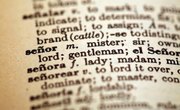Native Spanish speakers have advantages in learning English. For example, they often acquire a vocabulary quickly because of the many similarities in English and Spanish words. However, they do have particular difficulties in mastering English. If you teach ESL to native speakers of Spanish, an understanding of their problems with pronunciation, vocabulary, grammar, spelling and punctuation will help you meet their needs more effectively.
Pronunciation Difficulties
Spanish speakers learning English frequently have problems with pronunciation because of the differences between the two languages' sound systems. English has 12 vowels and eight diphthongs, while Spanish has only five of each. Spanish speakers, therefore, often have trouble distinguishing between words like "beat" and "bit." They also confuse the consonants "v" and "b" and the "s" as in "Sue" with the sound of "z" in "zoo." Since Spanish has an "e" before "s" on word beginnings, they find an initial "s" difficult to pronounce. They frequently add an "e" sound, which makes "sock" into "esock." Spanish rhythm gives syllables equal length, while English gives more time to accented syllables. The even rhythm in English of some Spanish speakers can make them difficult to understand.
Vocabulary Difficulties
The large number of similar words in Spanish and English has disadvantages as well as advantages. Many false cognates confuse the Spanish student of English. These pairs sound alike but have different meanings. Some of these false cognates in English and Spanish include "assist" and "asistir;" "college" and "colegio;" "exit" and "éxito;" and "library" and "librería." In addition, Germanic components of English, such as phrasal verbs like "look for," are often more difficult for Spanish speakers than the Latin or French-derived vocabulary.
Grammar Difficulties
English grammar is particularly confusing to Spanish speakers. Because Spanish has more verbs endings than English, a complete sentence in Spanish does not always need a subject. Because of this, Spanish speakers often omit subject pronouns from their English sentences. They tend to copy Spanish word order, departing from the required subject-verb-object order of English structure. Forming negatives and questions with "do" presents difficulties since Spanish negatives and questions do not require helping verbs. Spanish speakers also sometimes have trouble using the correct gender for third person singular possessive adjectives, since Spanish can use "su" for "her," "his" or "its."
Spelling and Punctuation Difficulties
Those who speak Spanish have trouble with English spelling, coming as they do from a more phonetic system. The different ways to spell the same sound in English can cause problems, as in words like "tough" and "fluff." The large number of vowel sounds and diphthongs are also troublesome. Native Spanish speakers often simplify English clusters of two or three consonants and are confused by when to spell double or single letters. They sometimes put exclamation points or question marks at both the beginning and end of sentences in writing. In addition, they frequently use commas to connect independent clauses, resulting in comma splices.










